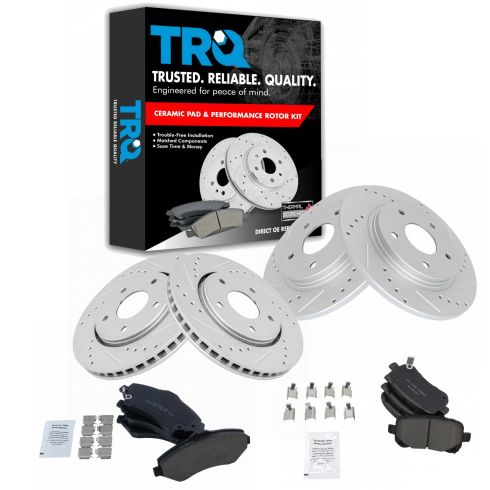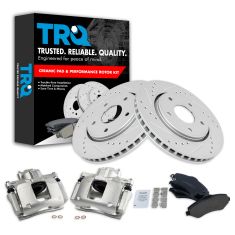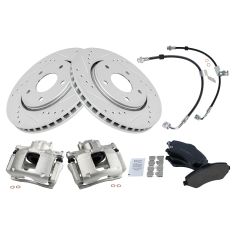1APBS00210-Dodge Ram VW Chrysler Front & Rear Ceramic Performance Brake Pad & Rotor Kit TRQ Performance BKA12203

Replaces
2012 Dodge Journey with 11.88 in. (302mm) Diameter Front Rotors with 12 in. (305mm) Diameter Rear Rotors with Single Piston Front Calipers Front & Rear Ceramic Performance Brake Pad & Rotor Kit TRQ Performance BKA12203

Product Reviews
Loading reviews
4.54/ 5.0
26
26 reviews
Good Value
June 23, 2017
I have put a few thousand miles on these rotors and pads. A little rumble between 60-40 mph when braking. This is likely a result of the vented rotors. Otherwise effective and quiet. I would buy again.
Brake kit
January 6, 2018
I found the best price at 1a auto . Every thing fit just right . I wish they had put stickers on the rotors to let you know which was left or right
Excellent
February 25, 2018
Very good quality and fit perfectly. more than 1/2 price saving from local, and virtually all parts are made in China or overseas now anyways. No complaint on what A1 Auto provided, but I wish they would have included new brake pad clips and the little rubber sleeves along with a dab of lubricant. I bought that kit at a local parts dealer for $10 so including it in with A1's parts could only add a few dollars more to their price. What you get is excellent, just a bit short of what you need to do the job right.
My opinion
April 3, 2018
Very good parts & price. I advise it to everybody.
October 18, 2018
Recib a tiempo el kit, de frenos. Excelente atencin ya que reciba notificaciones de todo el recorrido. Excelente calidad, los recomiendo 100%.
So far, very good
February 13, 2019
I've only done the front set and ran out of time and will finish the back in a little bit, but I am very satisfied with the break pads and rotors. They all seem like very high quality and they shipped extremely fast when I really needed them. I'll definitely buy from this site again and wouldn't hesitate to buy these brands again.
Discs and pads
May 1, 2019
Great parts fast shipping and so far so good
Never shop anywhere else!
June 11, 2019
Since I started using 1 A Auto I dont plan on using anyone else. The pets are unbelievably priced and I have had no problems. They ship fast and usually arrive within a couple days. I personally stamp my approval with this company! -Andrew Ames, Albany New York.
Needed more parts
July 11, 2019
Rotors and pads were just what I wanted and replaced originals well. I had to reuse the spring steel inserts in the brackets which are for the pads to slide in, I would have given this deal five stars if the inserts had been included or if I had been advised that I needed these parts.
Fast shipping
July 21, 2019
Fast shipping
Happy with Purchase
July 25, 2019
Rotors and pads have been installed for 2 weeks. Fit was perfect and product as described. Would buy again.
Rotor and pad kit.
August 6, 2019
I ordered the brake rotor and pads for my Dodge Journey. They arrived in two days. Everything fit perfectly and works well. The price was very good.
five star help
August 6, 2019
the parts did the job and work and sound good. A1 service
2009 town and country
August 8, 2019
It worked well was cheap and shipped fast. Thanks
Good brake parts
March 4, 2020
The parts are perfectly fit my suv I will recommend this parts
Good products highly recommend
August 25, 2020
I like there parts and prices with quick shipping easy detail description on each part they offer and good bundles prices in parts needed
Replaced when replaced hubs
September 16, 2020
fit good,, look good. Not sure that my hot rod of a minivan needs drilled and slotted rotors, but the price is way cheaper then I can get anything local and that is for non slotted rotors. The hardware for brakepads seem of better quality then the local stores carry. Only problem i had was on one of the brake pads the shim on the back fell off before installing. Would definitely recommend. Love ceramic brake pads, so that was my main reason for purchasing this particular set.
Best value around
September 20, 2020
Love these rotors and the pads are very nice. Definitely the best my van has ever stoped. I would highly recommend these
Excellent package deal.
October 20, 2020
Took a gamble on this and payed off. Never had drilled and slotted rotors before. They have outlasted any others so far. The one seems to give me a little bit of a grinding sound when it gets too warm.
Can't beat the price
January 26, 2021
Run the highway a lot stopping starting Better brakes for the money
No impressed at all.
July 18, 2021
These are the worst breaks Ive ever purchased. They sound terrible when you come to a stop. I would not recommend these to anyone.
September 5, 2021
The front brake pads or flat, they make noise and theres no room or way for them to disperse the heat, usually they have a curve on the brake pads as well as a middle wear indicator, which usually helps with heat as well, over all the front brake pads or the only complaint that I have on these
September 14, 2021
Great performance and very well made. Very satisfied. Definitely will buy same for all my vehicles as needed
we like it
April 19, 2022
excelent quality.
September 23, 2022
Good product, fast shipping. Good seller
Great parts
June 5, 2024
Everything went well parts fit perfectly
Customer Q&A
No questions have been asked about this item.
Dodge is a registered trademark of FCA US LLC. 1A Auto is not affiliated with or sponsored by Dodge or FCA US LLC.
See all trademarks.

















